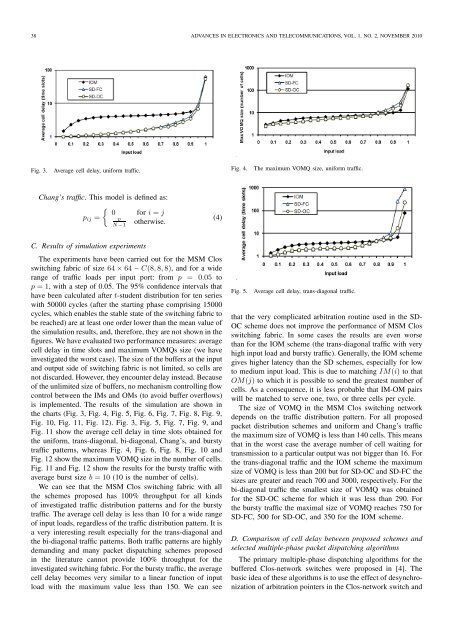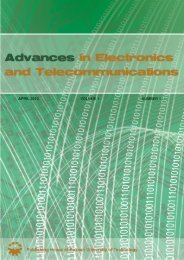november 2010 volume 1 number 2 - Advances in Electronics and ...
november 2010 volume 1 number 2 - Advances in Electronics and ...
november 2010 volume 1 number 2 - Advances in Electronics and ...
Create successful ePaper yourself
Turn your PDF publications into a flip-book with our unique Google optimized e-Paper software.
38 ADVANCES IN ELECTRONICS AND TELECOMMUNICATIONS, VOL. 1, NO. 2, NOVEMBER <strong>2010</strong><br />
Fig. 3. Average cell delay, uniform traffic.<br />
Chang’s traffic. This model is def<strong>in</strong>ed as:<br />
�<br />
0 for i = j<br />
pij =<br />
otherwise.<br />
p<br />
N−1<br />
C. Results of simulation experiments<br />
The experiments have been carried out for the MSM Clos<br />
switch<strong>in</strong>g fabric of size 64 × 64 – C(8, 8, 8), <strong>and</strong> for a wide<br />
range of traffic loads per <strong>in</strong>put port: from p = 0.05 to<br />
p = 1, with a step of 0.05. The 95% confidence <strong>in</strong>tervals that<br />
have been calculated after t-student distribution for ten series<br />
with 50000 cycles (after the start<strong>in</strong>g phase compris<strong>in</strong>g 15000<br />
cycles, whichenablesthe stable state ofthe switch<strong>in</strong>g fabricto<br />
be reached)are at least oneorderlower than the mean valueof<br />
the simulationresults,<strong>and</strong>,therefore,theyarenotshown<strong>in</strong> the<br />
figures.Wehaveevaluatedtwoperformancemeasures:average<br />
cell delay <strong>in</strong> time slots <strong>and</strong> maximum VOMQs size (we have<br />
<strong>in</strong>vestigatedtheworst case).Thesize ofthebuffersat the<strong>in</strong>put<br />
<strong>and</strong> output side of switch<strong>in</strong>g fabric is not limited, so cells are<br />
not discarded.However,theyencounterdelay<strong>in</strong>stead. Because<br />
oftheunlimitedsizeofbuffers,nomechanismcontroll<strong>in</strong>gflow<br />
control between the IMs <strong>and</strong> OMs (to avoid buffer overflows)<br />
is implemented. The results of the simulation are shown <strong>in</strong><br />
the charts (Fig. 3, Fig. 4, Fig. 5, Fig. 6, Fig. 7, Fig. 8, Fig. 9,<br />
Fig. 10, Fig. 11, Fig. 12). Fig. 3, Fig. 5, Fig. 7, Fig. 9, <strong>and</strong><br />
Fig. 11 show the average cell delay <strong>in</strong> time slots obta<strong>in</strong>ed for<br />
the uniform, trans-diagonal, bi-diagonal, Chang’s, <strong>and</strong> bursty<br />
traffic patterns, whereas Fig. 4, Fig. 6, Fig. 8, Fig. 10 <strong>and</strong><br />
Fig.12showthemaximumVOMQsize <strong>in</strong>the<strong>number</strong>ofcells.<br />
Fig. 11 <strong>and</strong> Fig. 12 show the results for the bursty traffic with<br />
average burst size b = 10 (10 is the <strong>number</strong> of cells).<br />
We can see that the MSM Clos switch<strong>in</strong>g fabric with all<br />
the schemes proposed has 100% throughput for all k<strong>in</strong>ds<br />
of <strong>in</strong>vestigated traffic distribution patterns <strong>and</strong> for the bursty<br />
traffic. The average cell delay is less than 10 for a wide range<br />
of <strong>in</strong>putloads, regardlessof the traffic distributionpattern.It is<br />
a very <strong>in</strong>terest<strong>in</strong>g result especially for the trans-diagonal <strong>and</strong><br />
the bi-diagonal traffic patterns. Both traffic patterns are highly<br />
dem<strong>and</strong><strong>in</strong>g <strong>and</strong> many packet dispatch<strong>in</strong>g schemes proposed<br />
<strong>in</strong> the literature cannot provide 100% throughput for the<br />
<strong>in</strong>vestigatedswitch<strong>in</strong>gfabric.Fortheburstytraffic,theaverage<br />
cell delay becomes very similar to a l<strong>in</strong>ear function of <strong>in</strong>put<br />
load with the maximum value less than 150. We can see<br />
(4)<br />
Fig. 4. The maximum VOMQ size, uniform traffic.<br />
Fig. 5. Average cell delay, trans-diagonal traffic.<br />
that the very complicated arbitration rout<strong>in</strong>e used <strong>in</strong> the SD-<br />
OC scheme does not improve the performance of MSM Clos<br />
switch<strong>in</strong>g fabric. In some cases the results are even worse<br />
than for the IOM scheme (the trans-diagonal traffic with very<br />
high <strong>in</strong>put load <strong>and</strong> bursty traffic). Generally, the IOM scheme<br />
gives higher latency than the SD schemes, especially for low<br />
to medium <strong>in</strong>put load. This is due to match<strong>in</strong>g IM(i) to that<br />
OM(j) to which it is possible to send the greatest <strong>number</strong> of<br />
cells. As a consequence, it is less probable that IM-OM pairs<br />
will be matched to serve one, two, or three cells per cycle.<br />
The size of VOMQ <strong>in</strong> the MSM Clos switch<strong>in</strong>g network<br />
depends on the traffic distribution pattern. For all proposed<br />
packet distribution schemes <strong>and</strong> uniform <strong>and</strong> Chang’s traffic<br />
themaximumsize ofVOMQislessthan140cells.Thismeans<br />
that <strong>in</strong> the worst case the average <strong>number</strong> of cell wait<strong>in</strong>g for<br />
transmission to a particular output was not bigger than 16. For<br />
the trans-diagonal traffic <strong>and</strong> the IOM scheme the maximum<br />
size of VOMQ is less than 200 but for SD-OC <strong>and</strong> SD-FC the<br />
sizes are greater <strong>and</strong> reach 700 <strong>and</strong> 3000, respectively. For the<br />
bi-diagonal traffic the smallest size of VOMQ was obta<strong>in</strong>ed<br />
for the SD-OC scheme for which it was less than 290. For<br />
the bursty traffic the maximal size of VOMQ reaches 750 for<br />
SD-FC, 500 for SD-OC, <strong>and</strong> 350 for the IOM scheme.<br />
D. Comparison of cell delay between proposed schemes <strong>and</strong><br />
selected multiple-phase packet dispatch<strong>in</strong>g algorithms<br />
The primary multiple-phase dispatch<strong>in</strong>g algorithms for the<br />
buffered Clos-network switches were proposed <strong>in</strong> [4]. The<br />
basic ideaofthese algorithmsisto use theeffectofdesynchronization<br />
of arbitration po<strong>in</strong>ters <strong>in</strong> the Clos-network switch <strong>and</strong>







